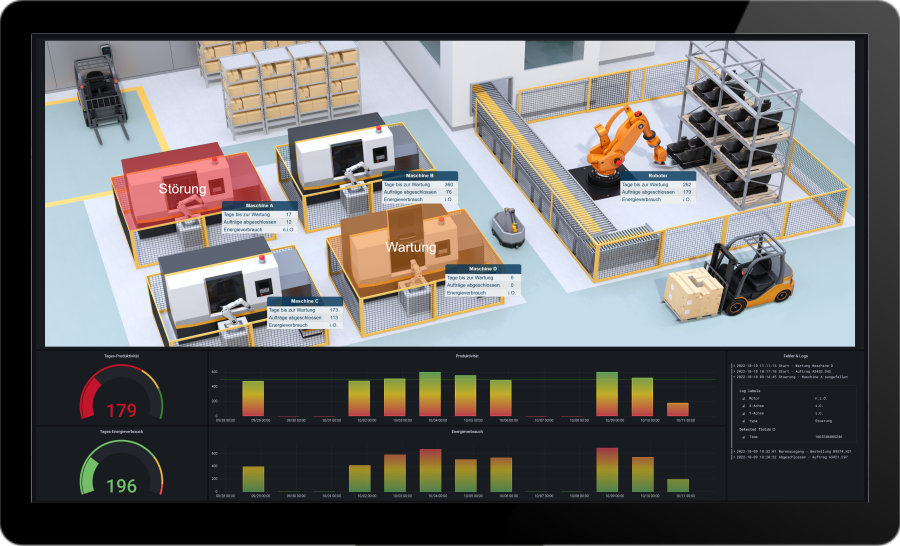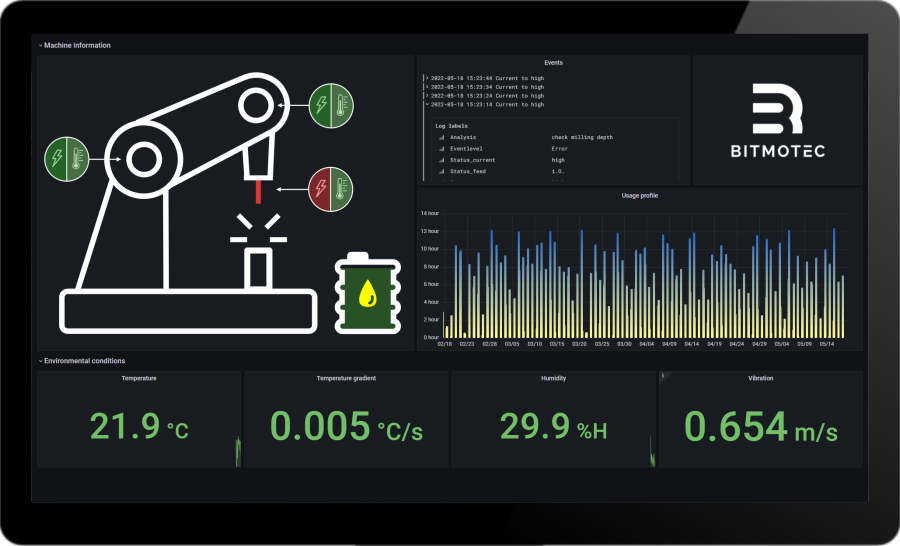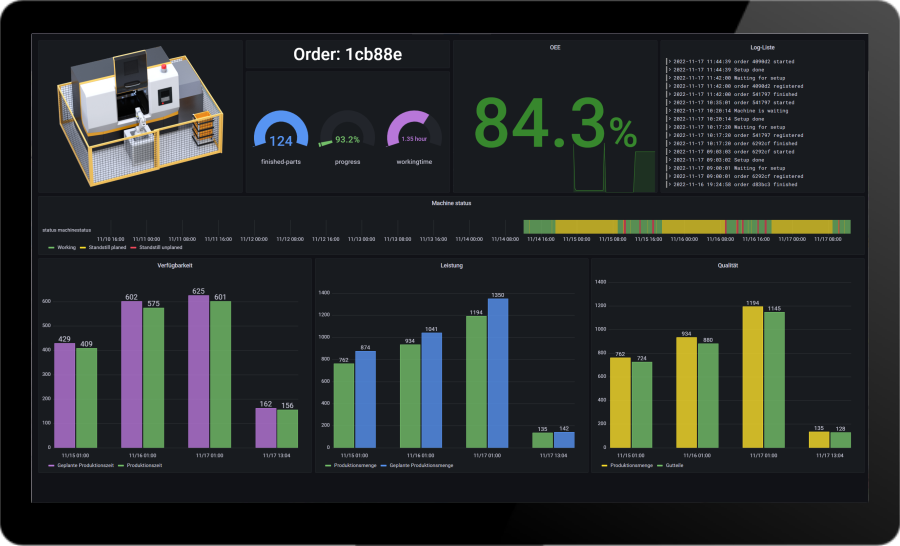Condition monitoring in industrial applications

BITMOTECO Machine Monitoring
The modular condition monitoring system for production.
Arrange a demo appointment now to coordinate your test operation.
Introduction
In modern industry, condition monitoring plays a crucial role in efficient production processes. By continuously monitoring the condition of the machine, it helps to reduce unplanned downtimes and optimize maintenance, for example. This section explains in more detail the basics as well as the importance for maintenance and operation as well as the components of a condition monitoring system (CMS).
Definition
Condition monitoring is the process of monitoring machines and systems in real time. As a result, companies can ensure the desired performance, efficiency and reliability at all times. By analysing operational data such as temperature, pressure, vibration or noise emissions, potential problems can be detected and rectified at an early stage, even before they lead to serious faults or expensive failures.
Importance for maintenance and operation
The implementation of a condition monitoring system offers companies a variety of advantages. These include, for example: reducing downtimes, improving plant availability, extending the service life of machines and systems as well as minimizing maintenance and repair costs. Predictive maintenance is also possible. Based on this, maintenance can be carried out based on the actual condition data of the machine, rather than companies having to rely on preventive measures based solely on fixed time intervals or statistical forecasts.
Historical overview
The beginnings of condition monitoring systems date back to the 1950s, when the first approaches were developed to monitor vibrations and temperatures in large steam turbines and generators. Since then, there has been a strong evolution of the systems, as a result of which a variety of measurement methods and technologies have been developed. Components such as the possibility of extensive data processing, new communication technologies and artificial intelligence have led to strong progress, especially in the last two decades.
Condition Monitoring System (CMS) – System Structure, Components and Integration
A condition monitoring system consists of several components, which together enable monitoring, analysis and evaluation of the machine condition. These include, for example, sensors, data acquisition units, communication and network infrastructure, data processing and analysis software, and user interfaces for visualizing and monitoring the results. The integration of a CMS into a company’s existing IT infrastructure, such as Enterprise Resource Planning (ERP) or Manufacturing Execution System (MES) software, not only enables efficient management of maintenance resources, but also the optimization of maintenance and production processes. By combining machine statuses with other operational information, companies can obtain a holistic overview of the performance of their systems and machines. Based on these insights, companies can make well-founded decisions and thus continuously increase their efficiency and competitiveness.
Common Measurement Methods in Condition Monitoring
In practical application, a variety of measurement methods are used to monitor the condition of machines and systems. The choice of the right method depends on the specific requirements and circumstances of the respective application. Here are some examples:
Vibration Analysis / Vibration Analysis
Vibration analysis is a widely used method and enables the monitoring of mechanical vibrations that occur in rotating or oscillating machine components (e.g. machine drives). Increased vibration amplitude can indicate, for example, imbalance, misalignment, bearing damage or wear. Continuous measurement and analysis of vibration signals leads to early detection of problems. This means that these can be remedied even before machine failures occur.
Ultrasonic testing
Ultrasonic testing is another common method in condition monitoring, which uses sound waves with frequencies above the audible range, and as a result detects e.g. material defects, cracks or corrosion in machine components. It is particularly suitable for monitoring high-pressure vessels, pipelines and structures. As a result of the early detection of material defects, the risk of equipment failures and safety problems can be significantly reduced.
Thermography
Thermography is an imaging method based on infrared radiation, which makes it possible to visualize the surface temperatures of machines and systems. This makes it possible to detect temperature anomalies, which in turn indicate excessive friction, poor heat dissipation, electrical malfunctions or other problems, for example. Thermography also allows contactless and fast monitoring of large plant areas and accordingly leads to improved efficiency and safety in companies.
Oil level monitoring
Oil level monitoring is an important method for monitoring hydraulic systems, transmissions, and engines. Continuous monitoring of the oil level and oil quality helps to detect lubricant shortages, contamination or wear particles at an early stage. Timely maintenance measures, such as oil changes or filter cleaning, prevent machine failures and also extend the service life of the system components
Acoustic Emission Testing
Acoustic emission testing is an acoustic monitoring in condition monitoring that records noise and vibrations in the audible and ultrasound-based range. As a result, the identification of anomalies in machinery and equipment is convenient. Noise emissions can be e.g. due to material defects, friction, cracks but also other mechanical problems. Based on the analysis of the sound emissions and their frequency spectra, experts can draw conclusions about the condition of the monitored machines and identify potential problems at an early stage.
In short, these measurement methods offer effective options for monitoring the condition of machines and systems. In addition, the combination of different methods provides comprehensive monitoring and thus helps to ensure the reliability, efficiency and safety of the equipment.

Advantages
This section discusses some of the key benefits.
- Reduction of unplanned downtime
By detecting anomalies and potential problems at an early stage, unplanned downtime of machines and systems can be reduced. Continuous monitoring makes it possible to plan and carry out maintenance measures at an early stage in order to minimize downtime.
- Improve Overall Equipment Effectiveness (OEE)
Condition monitoring can help improve overall equipment effectiveness (OEE) by enabling production processes to be optimized and bottlenecks or weak points to be identified. A better OEE means a higher utilization of the equipment and thus higher productivity.
-
Improvement of process flows
By analysing the data collected from condition monitoring, process flows can be improved. The insights gained can help identify and optimize bottlenecks and inefficient processes, resulting in increased productivity and efficiency.
-
Increasing energy efficiency
Condition monitoring can also contribute to increasing energy efficiency by making it possible to optimize the energy consumption of plants. By identifying energy consumption patterns and inefficient processes, targeted energy-saving measures can be taken.
-
Detection of wear and possible failures
Condition monitoring enables continuous monitoring of machines and systems in order to detect signs of wear, faults or performance losses at an early stage. By detecting such problems early, companies can plan preventive maintenance actions and avoid unplanned downtime that can lead to high costs and lost production.
-
Improve maintenance operations to reduce maintenance costs
By continuously monitoring the equipment and detecting anomalies at an early stage, maintenance work can be carried out in a more targeted and efficient manner. As a result, maintenance costs can be reduced and the availability of the systems can be increased.
-
Economic Evaluation of a Condition Monitoring System
The implementation of a condition monitoring system requires an investment in technology, personnel and infrastructure. An economic assessment can help weigh the costs and benefits and assess the profitability of the system. The economic benefits achieved through effective monitoring and maintenance of machinery and equipment can quickly offset investment costs and lead to a competitive advantage in the long run.
Implementation of a Condition Monitoring System: Case Studies
The implementation requires a systematic approach and close cooperation between different departments in the company. In the following, we will present some important steps in the implementation using case studies as an example.
Example 1: Reduction of unplanned downtime and improvement of machine availability
A condition monitoring system was successfully implemented at a manufacturer of industrial equipment. By adopting the automated CMS, the company was able to reduce the number of unplanned downtimes and improve machine availability . The system monitors the conditions of the workstations and provides an accurate picture of the production processes.
Example 2: Implementation of a condition monitoring system for inhomogeneous machinery
Another success story is the implementation at a medium-sized company with inhomogeneous machinery. With the introduction of central condition monitoring, all machines and equipment can now be monitored, regardless of age, manufacturer or technology. The system allows the company to increase efficiency and save on energy costs.

Challenges and limitations in industrial use
Technical Challenges
The technical challenges involved in implementing condition monitoring systems can vary greatly depending on the type and age of the equipment. In addition, the selection of suitable sensors and measuring devices, the integration of the data into existing systems and the analysis and interpretation of the data require specialist knowledge and experience.
Machine Connection and Sensor Interfaces
The connection of machines and systems to the condition monitoring system requires suitable sensor interfaces and a suitable IT infrastructure. Integration into existing system landscapes such as ERP or MES systems can be complex and requires a careful approach. Especially for the integration of intelligent sensors, the IT infrastructure must be prepared.
Cost and time constraints
Integrating a CMS requires an investment in technology, people, and infrastructure. Costs can vary greatly depending on the size and complexity of the machines, equipment and systems. The time required to implement and train staff can also be challenging. For this reason, an economic analysis of the use case is recommended.
Challenges in data management and analysis
The management and analysis of the data from the condition monitoring system requires special knowledge and skills. The analysis of large amounts of data requires high-performance IT systems and suitable analysis methods. The integration of data into existing systems and processes requires close cooperation between the specialist departments.
Innovations: The Future of Predictive Maintenance
The further development of condition monitoring systems and the integration of new technologies open up new possibilities for predictive maintenance. Compared to preventive maintenance, this is based on the actual condition of the equipment and not on the average or expected service life. As described above, the established methods include, for example, vibration analysis, ultrasonic testing, thermography, oil level monitoring and also acoustic emission testing. These procedures monitor the machines and, as a result, allow for the early detection of anomalies and potential problems.
The Role of Artificial Intelligence (AI) and Machine Learning
The integration of artificial intelligence (AI) and machine learning into condition monitoring systems opens up new possibilities for predictive maintenance. By analyzing large amounts of data, patterns and correlations can be identified, which can then be used to predict future anomalies and failures. Subsequently, targeted maintenance planning and execution is possible. The goal is to minimize downtime.
Another benefit of AI and machine learning is the automation of decision-making processes. Based on the integration of machine learning algorithms, decisions can be made and implemented automatically. As a result, the efficiency and speed of maintenance operations is improved.

Result
Condition monitoring offers a variety of advantages for machine operation as well as industrial maintenance. The early detection of anomalies and potential problems enables targeted maintenance planning and execution in order to minimize downtime and increase the efficiency of equipment as a result (cf. Overall Equipment Effectiveness (OEE)
The integration of new technologies, such as artificial intelligence and machine learning, opens up new possibilities for predictive maintenance. The analysis of large amounts of data makes it possible to predict future anomalies and failures, guaranteeing targeted maintenance planning and execution.
The implementation of a condition monitoring system requires a certain know-how in different technologies and thus delivers great added value. An economic assessment can also help to weigh up the costs and benefits and to assess the profitability of the system for companies.
More on the topic:
Hannover | Braunschweig | Oldenburg | Osnabrück | Göttingen | Celle | Lüneburg | Hameln | Aurich | Leer | Diepholz | Emsland | Gifhorn | Uelzen | Cuxhaven | Hamburg | Bremen | Niedersachsen |
